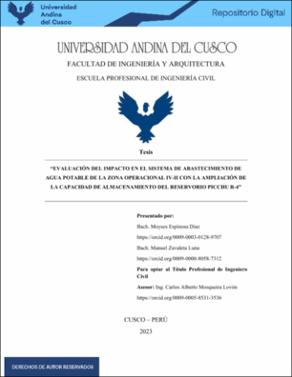| dc.contributor.advisor | Mosqueira Lovón, Carlos Alberto | |
| dc.contributor.author | Espinosa Diaz, Moyses | |
| dc.contributor.author | Zavaleta Luna, Manuel | |
| dc.date.accessioned | 2023-11-27T22:16:11Z | |
| dc.date.available | 2023-11-27T22:16:11Z | |
| dc.date.issued | 2023-06-28 | |
| dc.identifier.uri | https://hdl.handle.net/20.500.12557/5871 | |
| dc.description.abstract | El acceso de agua potable es un derecho humano reconocido internacionalmente, por
dicho motivo los gobiernos y autoridades tienen responsabilidad de garantizar el acceso de
agua potable a la ciudadanía a fin de prevenir las enfermedades infecciosas y la propagación
tanto de virus como bacterias, así como para garantizar el desarrollo cotidiano de las personas.
En ese sentido, los sistemas de abastecimiento de agua potable son fundamentales para
garantizar que la población tenga acceso a agua limpia y segura para beber, cocinar, lavar.
Estos deben de cumplir los parámetros establecidos por la Superintendencia Nacional de
Servicios de Saneamiento (SUNASS).
La presente investigación se desarrolla, haciendo el uso del modelamiento hidráulico,
buscó evaluar el impacto que será determinado por la eficiencia hidráulica de la red de
distribución de agua potable de la zona operación IV-II, ubicada en el del distrito de Santiago,
provincia Cusco y región Cusco, con el fin de ayudar a disminuir las deficiencias, actuales y
futuras, que puedan presentarse ante el proyecto de mejoramiento del Reservorio R-4. Para
ello, se realizó la modelación de la red en estado actual, tomando información del consumo por
tipo de conexión a través del registro histórico de datos de la EPS SEDACUSCO S.A. y
también utilizando un Caudalímetro Portátil para recolectar datos in-situ de la Línea
Umanchata que abastece la zona descrita anteriormente. El comportamiento real se obtuvo
verificando los distintos valores de diseño y se consideró el agua no facturada (ANF), como
datos a futuro, se asumió el incremento en el volumen de almacenamiento del reservorio R-4
según el proyecto que la EPS SEDACUSCO tiene para esta zona, y así, evaluar su influencia
en la red de abastecimiento de agua potable y poder analizar la variación de los parámetros de
dotación, continuidad del servicio de agua potable, presión y el coeficiente de caudal máximo
horario. | es_PE |
| dc.description.abstract | Access to drinking water is an internationally recognized human right, for this reason
governments and authorities have a responsibility to guarantee access to drinking water to
citizens in order to prevent infectious diseases and the spread of both viruses and bacteria, as
well as to ensure the daily development of people. In this sense, drinking water supply systems
are essential to guarantee that the population has access to clean and safe water for drinking,
cooking, washing. These must meet the parameters established by the National
Superintendence of Sanitation Services (SUNASS).
The present investigation, using hydraulic modeling, seeks to evaluate the hydraulic efficiency
of the drinking water distribution network of the IV-II operation zone, located in the Santiago
district, Cusco province and Cusco region, in order to Help reduce current and future
deficiencies that may arise in the R-4 Reservoir improvement project. For this, the modeling
of the network in its current state was carried out, taking information on consumption by type
of connection through the historical data record of the EPS SEDACUSCO S.A. and also using
a Portable Flowmeter to collect in-situ data from the Umanchata Line that supplies the area
described above. The real behavior was obtained by verifying the different design values and
non-revenue water (ANF) was considered, as future data, the increase in the storage volume of
the R-4 reservoir was assumed according to the project that EPS SEDACUSCO has for this
area, and thus, evaluate its influence on the drinking water supply network and be able to
analyze the variation of the endowment parameters, continuity of the drinking water service,
pressure and the coefficient of maximum hourly flow. | en_US |
| dc.format | application/pdf | es_PE |
| dc.language.iso | spa | es_PE |
| dc.publisher | Universidad Andina del Cusco | es_PE |
| dc.rights | info:eu-repo/semantics/openAccess | es_PE |
| dc.rights.uri | https://creativecommons.org/licenses/by-nc-nd/4.0/ | es_PE |
| dc.subject | Modelamiento hidráulico | es_PE |
| dc.subject | Red de distribución | es_PE |
| dc.subject | Dotación | es_PE |
| dc.title | Evaluación del impacto en el sistema de abastecimiento de agua potable de la zona operacional IV-II con la ampliación de la capacidad de almacenamiento del reservorio Picchu R-4 | es_PE |
| dc.type | info:eu-repo/semantics/bachelorThesis | es_PE |
| thesis.degree.name | Ingeniero Civil | es_PE |
| thesis.degree.grantor | Universidad Andina del Cusco. Facultad de Ingeniería y Arquitectura | es_PE |
| thesis.degree.discipline | Ingeniería Civil | es_PE |
| dc.publisher.country | PE | es_PE |
| dc.subject.ocde | https://purl.org/pe-repo/ocde/ford#2.01.01 | es_PE |
| renati.advisor.dni | 23874004 | |
| renati.advisor.orcid | https://orcid.org/0009-0005-8531-3536 | es_PE |
| renati.author.dni | 46395287 | |
| renati.author.dni | 72802325 | |
| renati.discipline | 732016 | es_PE |
| renati.juror | Pelaez Gamarra, Jackeline Alejandra | |
| renati.juror | Somocurcio Alarcón, Héctor Erick | |
| renati.juror | Gil Rodríguez, Carmen Cecilia | |
| renati.juror | Arohuanca Sosa, Rode Luz | |
| renati.level | https://purl.org/pe-repo/renati/level#tituloProfesional | es_PE |
| renati.type | https://purl.org/pe-repo/renati/type#tesis | es_PE |




